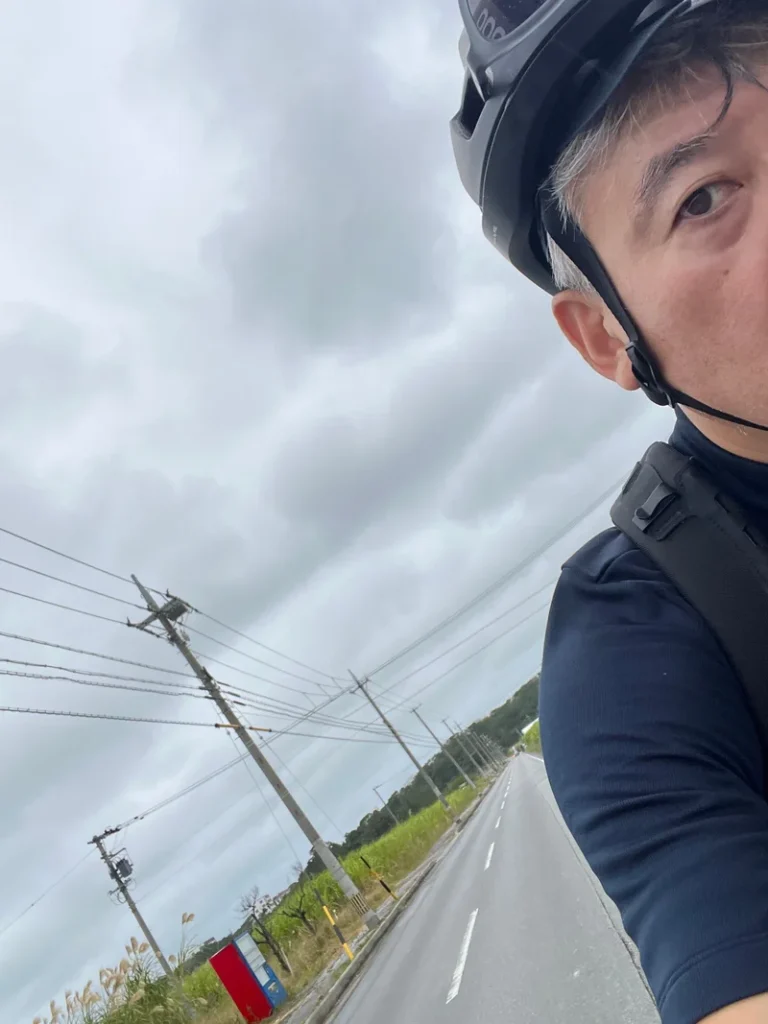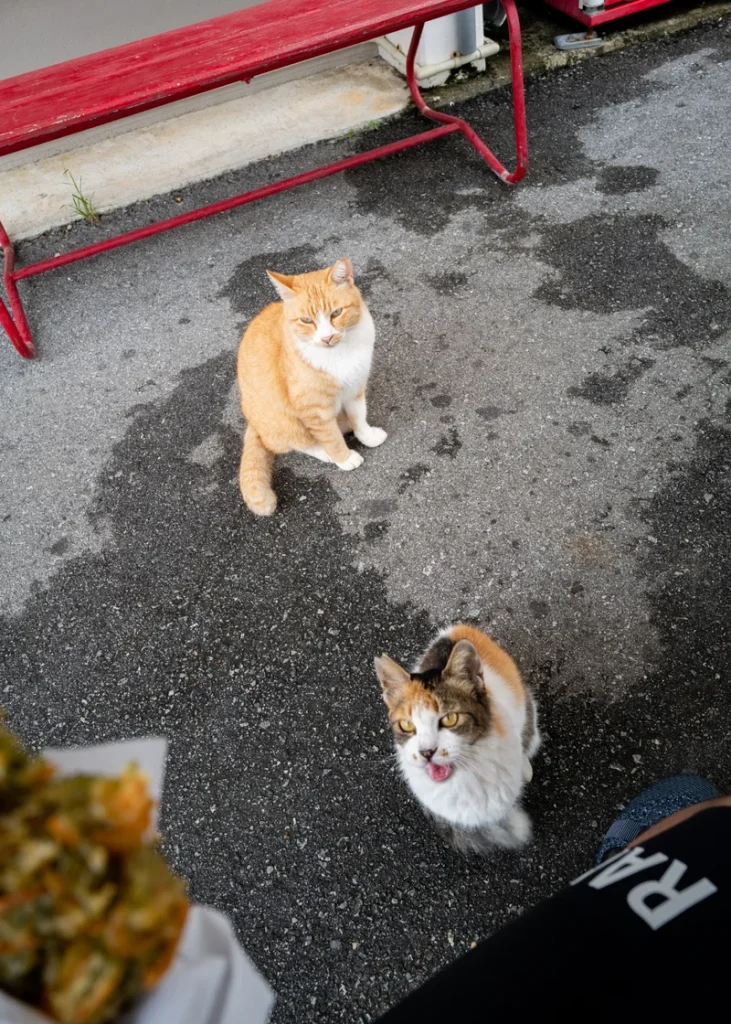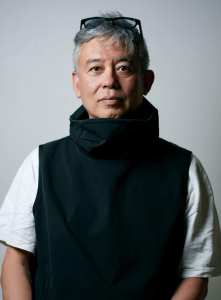TV Producer Daisaku Kawase’s Ride Note
Okinawa Edition #01
A still cat… Crispy tempura for 100 yen… A journey to explore the small islands of Okinawa by road bike.
Table of Contents
1. Devouring Naha
2. Contemplating Peace on the Detour Road
3. To the Island of Cats and Tempura
1. Devouring Naha
Sometimes, there are moments when you suddenly want to break away from your daily routine. It’s not that you dislike your job, but you feel the need for a change of environment. In such times, it’s good to grab your bicycle and go somewhere. Riding through unfamiliar lands with the wind in your face can clear away any lingering unease and enrich your life.
So, one day, I headed to Naha with my road bike.
In December 2023, Tokyo was already cold enough to require a coat. However, when I landed in Naha after just under a two-hour flight, the city welcomed me with temperatures where a T-shirt and shorts were more than sufficient.






Arriving at Naha, after leaving luggage at the hotel, the first priority is to satisfy your appetite.
This place is a gathering spot for delicious food. First, as a snack, I had Okinawan soba at Makishi Public Market. With just one bite, I couldn’t help but exclaim, “Delicious!” A bowl of such flavorful soba costs only 480 yen. The slightly sweet and rich taste, enhanced by the savory broth, makes you truly feel that you are in Okinawa.
That night, I had a tenderloin steak at J Jack’s Steak House. The meat was tender, and I enjoyed every bite. Both places were bustling with local people. Okinawa is wonderful.Though unrelated to cycling, this is also an essential part of the enjoyment of the journey.

The day started with an overcast sky, and sporadic raindrops began to fall. It seems the rain will stop in the afternoon, but with the delayed start, attempting a long ride might be challenging.
So, I decided to visit a place that has caught my interest for a while.
It’s a small island in the southern part of the main island, in Nanjo City. You can cross a bridge of about 100 meters to get there, and it’s known for having many cats. The tempura there is excellent, drawing a large number of people specifically for it. It’s about 20 kilometers south from Naha, and without detours, it should take around one hour by road bike.
The name of this island is Oujima.
An island where people flock to eat tempura—now that piques my curiosity.
2. Contemplating Peace on the Detour Road
The rain stopped around 1:00 PM.
Even with a few detours, I should be able to return before it gets dark. Leaving the hotel in Naha, I rode through the city and headed south. The number of traffic lights gradually decreased, making the ride smoother. At this rate, I might arrive quite early.
When I reached Haebaru Town, an intriguing sign caught my eye.
“Army Hospital Haebaru Cave Group No. 20”
Hmm, likely remnants of a hospital bunker from the fierce battles near the end of the war. I decided to deviate from the route and make a stop to explore.

Following the signs sporadically placed along the roadside, I proceeded and arrived at a vast park called Koganemori Park, which houses a baseball field and a track and field stadium. As I gradually advanced through the park, deep within the dense forest, a semicylindrical shape dome protruded. Stopping my bicycle, I climbed the stairs, and there it was – an underground cave, excavated as a military hospital during wartime.


Since the U.S. military landed in Okinawa, this place has been overflowing with critically ill patients, and surgeries, even without anesthesia, were conducted. The students of Himeyuri, too, worked as nursing assistants in such conditions. Thoughts about the Gaza Strip and Ukraine come to mind.
Several elderly people are preparing for something. Upon asking, I learned that today, students on a school trip are expected to visit, and they will guide them inside the trench. One of them, a woman in her 60s, approached and spoke to me. She was born during the post-war American occupation. She mentioned that she didn’t know until she was over 40 that this place was a military hospital and that the conditions were intense.
“At that time, they didn’t teach us about the Battle of Okinawa in schools. This trench was designated as a cultural asset of the town in 1990, and public access began in 2007. That became the trigger for me to become a storyteller. It was only when I started researching the events of that time that I learned what this trench was. Asking my parents about that time was also part of that process. Since childhood, I knew there were holes, but I didn’t know what they were, and the schools under American rule in Okinawa never taught us anything about it. Education can be controlled in that way, and I always talk about the scariness of it.”
I had to give up entering the trench this time because it’s not accessible without a guide. It seems that if you contact them in advance, they will do their best to accommodate. Facing such historical facts left by the war is something unique to Okinawa rides, especially in the southern part of Okinawa Island where traces of the war are scattered throughout.
3. To the Island of Cats and Tempura

Returning to the course, I aimed steadily southward. While not particularly steep, after crossing a long slope, the sea came into view.
From there, Ou Island was just ahead.
Upon descending the slope, I reached a short bridge connecting to the island. Taking advantage of having come this far, I took a selfie on the bridge. Despite low-hanging clouds, the sight of the sea still lifted my spirits.

Finally, landing on the island of cats and tempura.
It was the offseason on a cloudy weekday. As expected, the island was quiet. First, I aimed for a peculiar rock called Ryugushin located to the south of the island. The island is very small, with a circumference of only 1.7 kilometers. If you have a road bike, you can circle it in about 10 minutes.
When I reached the southern tip of the island, I locked eyes with a cat. I have a cat allergy, but I don’t dislike cats. Carefully, I pointed my camera without startling it and took a photo. I approached slowly, closing the distance, but on the third step, it ran away. If there was an old man approaching with sunglasses on, peering into a black camera, I would back away too. However, as rumored, encountering a cat made me a little happy.
The rock called Ryugushin stood tall in the sea. Its mysterious shape, resembling a giant eringi (king trumpet mushroom) , was both divine and intriguing. In that place where only the sound of waves echoed, I gazed at the sea for a while.





When I returned to the entrance of the island, I found a place selling tempura. Looking at the menu, everything was priced at 100 yen each—surprisingly cheap. I asked the staff what sells well, and they mentioned fish, mozuku seaweed, and sea grapes. So, I ordered these three items. Payment was made in advance. Once I paid, the shopkeeper started frying the tempura.



“Hi, thank you for waiting.”
I receive a paper bag from the shopkeeper containing piping hot tempura. There is no seating inside the shop, and it seems you eat on the bench placed in front of the shop.
First, the mozuku tempura.
When I take a bite, it’s piping hot, delightfully crispy, and just that makes me feel happy. The texture of the mozuku is pleasant. The combination of sweetness and slight bitterness mixes well, and I couldn’t help but exclaim, “Delicious.”
Next is the fish tempura. The ingredient seems to be tuna, and it’s like eating chicken nuggets, with umami spreading with every chew. Yes, it’s bliss.

I had been eating continuously until now, but suddenly I noticed a strong gaze. Two cats were staring intently at me. They have already closed the distance considerably. They must be aiming for the tempura. There’s one piece of tempura left, which is the sea grape. I drop a small piece to see. The cats show no interest whatsoever. I try dropping it again, but they continue to ignore it. Well, it seems they wanted the fish, which is already in my stomachs. I feel sorry for not being able to share, but the sea grape tempura is also crispy and delicious. I finished it under the watchful eyes of the cats. Although I was a bit concerned about the calories, considering I rode 20 km on the bike to get here and will ride 20 km back, it should balance out to zero.


Okinawa’s Ou Island is not too far from Naha, and with moderate ups and downs, it’s a quick round trip on a road bike. Himeyuri Tower is also nearby, and with a little extension, you can reach Seifa Utaki, considered the holiest place in the Ryukyu Kingdom.
Cycling in Okinawa offers various routes to enjoy, and the off-season like this time is recommended. In the next report, I will explore Naha City with activities such as the Shuri Castle hill climb, beloved local diners, and exquisite beaches.
Text & Photo_Daisaku Kawase
Reference Sites:
⚫︎Haebaru Town Official Website (Guidance for visiting Bunker No. 20 in the Haebaru Bunker Group)
https://www.town.haebaru.lg.jp/docs/2013030100037/
⚫︎Nanjo City Tourism Portal Site (Information on Ou Island included)
https://www.kankou-nanjo.okinawa/tokusyu/oujima/
Profile

Daisaku Kawase
He is a Free Producer, the Representative of Days Co., Ltd. Born in Aichi Prefecture. With 16 years of road cycling experience, he loves scenic rides. He squeezes in rides between work and travels all over Japan with his bike. His beloved bike is a Trek. After working as a producer on programs like “Ariyoshi no Okane Hakken Totsugeki! Kaneo-kun,” “Oyasumi Japan Nemuiine,” and “Asaichi” at NHK, he became independent in 2022. In addition to producing programs, he also handles project production for government and corporate clients.